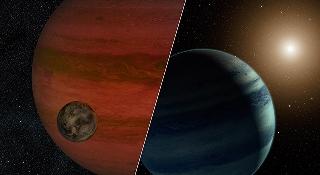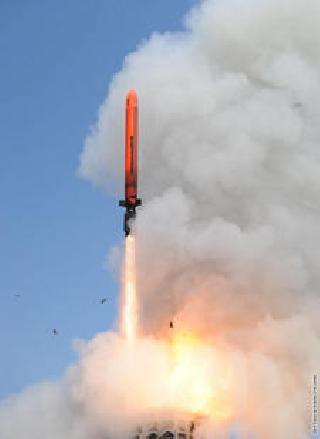
Researchers have detected the first 'exomoon' candidate. This artist's conception depicts the two possibilities, with the planet/moon pairing on the left, and star/planet on the right. Photo: NASA/JPL-Caltech.
PASADENA, CALIFORNIA (BNS): Researchers have spotted the first signs of an 'exomoon' - a moon orbiting a planet that lies outside the solar system - after watching a chance encounter of objects in our galaxy.
Using a technique called "microlensing," the researchers observed what could be either a moon and a planet -- or a planet and a star, NASA JPL said in a statement.
The scientists could not confirm the results partly because microlensing events happen once, due to chance encounters. The events occur when a star or planet happens to pass in front of a more distant star, causing the distant star to brighten.
"We won't have a chance to observe the exomoon candidate again," said David Bennett of the University of Notre Dame, lead author of a new paper on the findings appearing in the Astrophysical Journal. "But we can expect more unexpected finds like this."
The international study funded by NASA, is led by the joint Japan-New Zealand-American Microlensing Observations in Astrophysics (MOA) and the Probing Lensing Anomalies NETwork (PLANET) programmes.
The technique takes advantage of chance alignments between stars. When a foreground star passes between us and a more distant star, the closer star can act like a magnifying glass to focus and brighten the light of the more distant one.
If the foreground star -- or what astronomers refer to as the lens -- has a planet circling around it, the planet will act as a second lens to brighten or dim the light even more.
By carefully scrutinizing these brightening events, astronomers can figure out the mass of the foreground star relative to its planet.
In the new study, the nature of the foreground, lensing object is not clear. The ratio of the larger body to its smaller companion is 2,000 to 1.
That means the pair could be either a small, faint star circled by a planet about 18 times the mass of Earth -- or a planet more massive than Jupiter coupled with a moon weighing less than Earth.
"One possibility is for the lensing system to be a planet and its moon, which if true, would be a spectacular discovery of a totally new type of system," said Wes Traub, the chief scientist for NASA's Exoplanet Exploration Programme.
"The researchers' models point to the moon solution, but if you simply look at what scenario is more likely in nature, the star solution wins," he said.
The ground-based telescopes used in the study are the Mount John University Observatory in New Zealand and the Mount Canopus Observatory in Tasmania.
 Previous Article
Previous Article Next Article
Next Article













The Indian Air Force, in its flight trials evaluation report submitted before the Defence Ministry l..
view articleAn insight into the Medium Multi-Role Combat Aircraft competition...
view articleSky enthusiasts can now spot the International Space Station (ISS) commanded by Indian-American astr..
view article